
About UsThe Numismatic Bibliomania Society is a non-profit organization promoting numismatic literature. For more information please see our web site at coinbooks.org SubscriptionsThose wishing to become new E-Sylum subscribers (or wishing to Unsubscribe) can go to the following web page link MembershipThere is a membership application available on the web site Membership Application To join, print the application and return it with your check to the address printed on the application. Membership is only $15 to addresses in the U.S., $20 for First Class mail, and $25 elsewhere. For those without web access, write to: David M. Sundman, Secretary/TreasurerNumismatic Bibliomania
Society AsylumFor Asylum mailing address changes and other membership questions, contact David at this email address: dsundman@LittletonCoin.com SubmissionsTo submit items for publication in The E-Sylum, just Reply to this message, or write to the Editor at this address: whomren@coinlibrary.com
BUY THE BOOK BEFORE THE COINYou won't regret it! |
- WAYNE'S WORDS: THE E-SYLUM NOVEMBER 6, 2011
- NOBLE NOVEMBER 2011 SALE FEATURES NUMISMATIC LITERATURE
- DUPLICATE AUCTION CATALOGS OFFERED TO E-SYLUM READERS
- BOOK REVIEWS: NEW TITLES ON THE EISENHOWER DOLLAR
- ROBERT YUELL, 1936-2011
- DAVID J. DAVIS, 1938-2011
- ARCHER: AMERICAN NUMISMATIC SOCIETY'S NEW ARCHIVE CATALOG
- ANS MEDAL HONORING ERIC P. NEWMAN
- THE NUMISMATIST ONLINE PRESENT AND PAST
- IS COIN SEARCHING A WORLDWIDE ACTIVITY?
- QUERY: THOMAS ELDER PERIODICALS INFORMATION SOUGHT
- QUERY: 1856 FLYING EAGLE PATTERN INFORMATION SOUGHT
- MORE ON LIBYA'S STOLEN TREASURE OF BENGHAZI COIN COLLECTION
- STILL MORE ON AMERICAN FAROUK AUCTION ATTENDEES
- STILL MORE ON COINS AND MEDALS AND METEORITES
- NOTES FROM E-SYLUM READERS: NOVEMBER 6, 2011
- REPORT ON THE 2011 MEDALLIC SCULPTURE SYMPOSIUM
- COINS 'N' THINGS' $6.5 BILLION BUSINESS
- 17TH-CENTURY CHINESE COIN FOUND IN YUKON
- MORE ON THE 1841 MAUNDY THREEPENCE
- CANADA'S NEW POLYMER BANKNOTES CAUSING MACHINE PROBLEMS
- CASH MACHINE DISPENSES COCKNEY RHYMING SLANG
- FEATURED WEB SITE: THE JOHN REICH COLLECTORS SOCIETY
WAYNE'S WORDS: THE E-SYLUM NOVEMBER 6, 2011

Among our new subscribers this week are Rob Ezerman, P. Topping and W.J. Elvin. Welcome aboard! We have 1,469 email subscribers, plus 168 followers on Facebook, including Bob Leuver.
This week we open with notes from Colin Pitchfork and Heath MacAlpine, followed by reviews of two new books and sadly, notes on the loss of two U.S. numismatists and E-Sylum regulars.
Other topics this week include the ANS' new archive catalog, Tom Elder periodicals, Gaston DiBello, and the 2011 Medallic Sculpture Symposium.
To learn more about 1802 Half Dimes, the Numismatic Philistine, FROGs, the Armand Champa refrigerator magnet, and the ATM that converses in Cockney Rhyming Slang, read on. Have a great week, everyone!
Wayne Homren
Numismatic Bibliomania Society
NOBLE NOVEMBER 2011 SALE FEATURES NUMISMATIC LITERATURE
Colin Pitchfork of Australia writes:
 I thought it might be worth noting that in our next Auction Sale 98 (with Noble Numismatics), which can be seen on the internet web site www.noble.com.au has a number of numismatic books for sale. The auction is held in Sydney from the 22nd - 25th November 2011, and the books are lots ( 2908-2952 inclusive).
I thought it might be worth noting that in our next Auction Sale 98 (with Noble Numismatics), which can be seen on the internet web site www.noble.com.au has a number of numismatic books for sale. The auction is held in Sydney from the 22nd - 25th November 2011, and the books are lots ( 2908-2952 inclusive).
To view the literature section of the sale, see: www.noble.com.au/site/docs/cats/sale_98/A09.pdf
DUPLICATE AUCTION CATALOGS OFFERED TO E-SYLUM READERS
I recently purchased a lot of catalogs issued by Joe Levine's Presidential Coin and Antique Company, Inc. I now have a number of duplicates that I don't need, and would like to offer them gratis as a group to the first E-Sylum reader reader who contacts me; you just have to pick up the postage cost. I'm available at heathmacalpine@hotmail.com . The catalogs are:
#43 12/5/1987 The Robert Whitehead Collection, with prices realized (pr)
#44 6/25/1988 The Paul Magriel Collection, with pr
#60 2/21/1996
#61 11/16/1996
#64 7/10/1998 The Charles McSorley Collection of Nineteenth Century Political Campaign Tokens, with pr
#65 3/20/1999 Hard Times Sale, with pr
#66 11/13/1999 The Robert J. Centola Collections, with pr
#67 6/3/2000 with pr
#68 10/28/2000 The Richard B. Dusterberg Collection of Official Presidential Inaugural Medals and Memorabilia, with pr
#69 6/16/2001
#81 6/18/2011
BOOK REVIEWS: NEW TITLES ON THE EISENHOWER DOLLAR
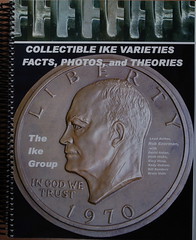
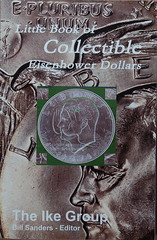
DOUBLE BOOK REVIEW: The Little Book of Collectible Eisenhower Dollars and Collectible Ike Varieties Facts-Photos-Theories by The IKE Group
On January 25th 1971, the monthly issue of Numismatic Scrapbook arrived in collectors mail boxes across America. A short article in this issue described to readers how the passage of a banking bill by Congress, with an amendment attached at the last second, had created the new Eisenhower or "Ike" dollar. The new dollar was originally intended to commemorate America's top General during WWII, and the 34th President of the United States.
When the coin was introduced to the American people there was a resounding thud as the weight of the coin fell right to the bottom of bank vaults and stayed there. Nobody wanted the heavy, cumbersome looking coins. However in the forty years since its introduction the coin has made somewhat of a comeback as a collectible. It is desired for two main reasons, the forty percent silver in some of the design types and the many and varying design types and varieties created by a somewhat flawed minting process.
The Eisenhower dollar has also been discovered by an esoteric group of collectors from the Interverse called the Ike Group. The Ike Group is Rob Ezerman, David Golan, Herb Hicks, Gary Hoop, Andy Oskam, William Sanders, and Brian Vaile. In their own words the Ike group is "from various professions, all with a compelling interest in the Eisenhower dollar coin. In a nut shell, our eight members include two retired physicians, two metallurgical engineers, a teacher, an ultrasound scientist, a certified genius, three strong entrepreneurs and a snake and 'gaiter hunter," (Ike Group, 2011).
It seems to me after studying their website and reading the IKE group's two books the Ike Group's mission is to gently sway the opinion of the third party graders from one of a passive nature to one of an active nature in regards to Ike die varieties. The group affectionately calls this work its DIVA program. DIVA stands for Designated Ike Variety. It has been the mission of the Ike group since 2008 when they formed, and continues to be so to this day and on the fortieth anniversary of the Eisenhower Dollar the group has published two books as a compilation of their work from 2005 to present.
In 2005 Brian Vaile and Rob Ezerman got together to discuss peg leg Ikes, and out of this conversation a discussion brewed about "the friendly eagle variety" as the group called it. A short note to those members of CONECA and other die variety specialists: this is known as a Reverse Design Variety and is labeled RDV-006 accordingly.
Rob Ezerman combined that conversation and a ton of data into an article in the Numismatist July 2007 issue. The members of the IKE group have contributed numerous articles to Errorscope and the Numismatist periodicals and these are at the core of their newest project and coin book called Collectible Ike Varieties Facts-Photos-Theories, which is authored by the group as a whole.
They have also published a smaller book called The Little Book of Collectible Eisenhower Dollars which will be useful at coin shows and auctions. This smaller version is written by the group as a whole and edited by Bill Sanders. The Ike group takes a risk by lumping varieties in with errors but by doing so saves the reader from having to view other source material in their collecting challenge.
The little book has twenty three chapters with each chapter about 3-5 pages in length with very good photographs in black and white. The images and markers for the pick-up points are clear and to the point with values listed for the popular grades. There is one glaring issue with this volume and it is the organization. The chapters are more like short stories and the Little book is not numbered in a conventional way but the table of contents is straightforward and for a smaller volume this is acceptable.
If you are really into error collecting and die varieties then you will want to get your hands on Collectible Ike Varieties Facts-Photos-Theories as the group calls their magnum opus. If you want to find out more information on metallurgy, tool and die making, and the whole minting process you will find a wealth of information in the Big book. Chapter 25 is especially helpful for theories concerning annealing, planchet metallurgy, die hardening, and steel alloy composition. This is by far the most in depth discussion I have ever read on the subject without attending formal training.
It is clear the group members are intelligent and this might actually be one of the failings of this volume, if there are any. The amount of work that has gone into this volume over the years is simply amazing. In Chapter 32 there is a review of the incomparable Del Romines theory on determining die states. There are many other chapters which required the painstaking research of United States Mint records, with discussions of behind the scenes decisions, and work processes.
The group has a unique method of describing Eisenhower die varieties as mentioned earlier in that common nomenclature used by the die variety collecting community and nomenclature used by the IKE group may be a bit challenging at first, as one must get used to the Ike groups use of terms. Names like friendly eagle, tiger claw, and shadow Ike will seem strange to some, but after reading the descriptions it soon becomes evident enough.
The only other issue I have with the big book is the organization. There is no index and cross referencing so much material is difficult for the novice. This volume like the Little book also has chapters like short stories and each chapter is numbered starting at one. This leaves no way for a body to look into the table of contents and go to a particular page - one needs to skim through the whole book in order to find a chapter and then look at the page numbers which at this point are meaningless.
Frankly, with so much effort put into this volume I find this to be particularly annoying and I wondered if it was the conscious decision of the writers because it caused me to look all the harder for information. According to the introduction of the Big Book there is another volume coming out early next year which is supposed to correct these deficiencies and the totality of the project will be complete and I must add monumental in its scope for one coin type, with this volume being as Ezerman says, "the deep end of the pool."
In conclusion I must say I had reservations about some of the terms and some of the IKE groups findings but I am old enough to know that things change and also that new challenges are exciting to collectors. The Big book is challenging and is written for the very serious collector, if you are into cherry picking great IKES at shows and auctions then buy the Little Book of Collectible Eisenhower Dollars to take with you.
If you really want to go more in depth and are challenged by the process of how the coins listed in the Little Book were minted, became rare and why these coins are collectible, then by all means go for the Big book of Collectible Ike Varieties Facts-Photos-Theories. Both volumes can be found by going to The IKE GROUP at: www.ikegroup.info
KOLBE & FANNING NUMISMATIC BOOKSELLERS WEBSITE
ROBERT YUELL, 1936-2011
Bob was an avid collector of half cents and half cent literature who earned the nickname "The Whister" because he relished setting up half cent whist matches with other advanced half cent collectors. In a whist match, participants compared their collections variety by variety. The participants receive one point for having the variety and one point for having the better coin. The collectors with the most points was the "winner".
Generally other half cent collectors were invited to the matches to serve as judges. Often a judge would display a particularly attractive example of the variety being contested (however, no points were awarded to the judge). Bob's goal was not to be the winner (although he really enjoyed winning) but to provide the opportunity for collectors to view some outstanding half cents that they otherwise might never be able to see and hold. In a very real sense, all the participants were winners in his whist matches. His whist matches increased the enjoyment of collecting half cents for all of us who were fortunate enough to participate.
In addition to half cents, Bob had a strong interest in the history of his home town, Plainsboro, NJ, and of transportation in New Jersey's early history. He was an avid collector of photographic post cards in both these areas. He was a very active member of the Plainsboro Historical Society and Museum and was its Executive Director from 2000-7. He also enjoyed driving in road rallies and bird watching.
Bob became aware that he would probably not win his battle with lung cancer and arranged to sell his beloved half cents. The Whister Collection was sold by the Goldbergs of Los Angeles at the beginning of last September. Bob attended the sale, sad to be parting with his half cents, but enjoying knowing they were all going to appreciative homes, mostly with collectors he had been friends with for many years. His health declined rapidly after his return from Los Angeles. Bob was 74 years old.
P. Scott Rubin writes:
The hobby lost a friend last Sunday (Ocober.30) when Bob Yuell. an avid Half Cent collector and bibliomaniac of literature related to Half Cents (especially any sale where coins he owned were sold), passed away after a lengthy illness.
He may be best known for taking part in many of EAC's Half Cent Whist matches. So much so that when he recently sold his collection by Ira & Larry Goldberg and McCawley-Grellman it was under the title The Whister Collection of Half Cents. His name was not mentioned in the catalogue but his picture and a preface written by Bob is included.
DAVID J. DAVIS, 1938-2011
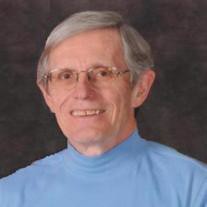 On November 1, the numismatic community lost a highly respected member - David Davis. I started corresponding with David more than 15 years ago when he resided in Ypsilanti, Michigan. When I was introduced to David as a collector of counterfeit detectors, I quickly realized his breadth of interests and depth of knowledge to include bust coinage, national bank notes, and Michigan tokens, among many other areas.
On November 1, the numismatic community lost a highly respected member - David Davis. I started corresponding with David more than 15 years ago when he resided in Ypsilanti, Michigan. When I was introduced to David as a collector of counterfeit detectors, I quickly realized his breadth of interests and depth of knowledge to include bust coinage, national bank notes, and Michigan tokens, among many other areas.
The Davis - Logan - Lovejoy - McCloskey - Subjack work titled Early United States Dimes, 1796-1837: a Reference Book of Their Type, Varieties and Rarity, 1984 set a new standard for subsequent bust coinage research. The quality of the work stands on its own merit as, 27 years later, no title has superseded this work. Only a single new bust dime variety has been discovered since the book was published. He made numerous contributions to the John Reich Society including holding the position of past president.
I met David in Cincinnati in early 2011 at which time he was doing quite well with cancer therapy - even plowing his own snow in the harsh Michigan winter. Last week, I was fortunate to meet David again at his home on the lake in Manchester, Michigan. Although he was clearly in immense discomfort, his mind was as sharp as an arrow and he shared with me many stories from his collecting days.
I also learned a new term: FROG - Finished Room Over Garage. When David constructed his new home on the lake in Manchester, he built the FROG as his "collecting cave." The room, fittingly painted green, must have a massive support structure as it was full of banker book cases, research material, and many modern heavy coated paper auction catalogs. Yet, there was zero settling in the floor !!! He will be sadly missed and fondly remembered.
The following is a summary from his family.
David Jerome Davis 8-3-38 to 11-2-11
David Jerome Davis lost his 2 1/2 year battle with cancer on Wednesday, November 2, 2011. David, 73, is survived by his loving wife Janet, daughters Ellen & Martha Waara (husband Charles Busha), grandson Joshua Waara, sisters Madonna (Herb) Duval, CHristine (Richard) RUssell of Cincinnati, OH and brother Darryl Davis of Pittsburgh, PA. Neices Verya Lyn, John, Kevin, Karen, Stephen, Eric, Jessica, Matthew and Alexder. Great uncle ot Caroline, Grethcen, Olivia, Colton and Rachel. David is preceded in death by his parents and sister, Paula (1999).
David retired from Ford Motor Company. He was an engineer there for 33 years. Following retirement, when he wasn't spending time on his numerous collections, he designed and build his uniquely beautiful, peaceful, energy efficient home on Pleasant Lake, Manchester, MI.
David interrupted his first job as draftsman at Owens Corning to spend four years in the Navy, mostly aboard the USS Independence during the Bay of Pigs invasion. He returned to Dearborn after the Navy, and stayed there until moving to Ford.
After his family, David's real passion was his collections starting with slide photos of covered bridges across America, but quickly moving to rare coins and paper money issued by the first 200 US banks.. David and two fellow collectors authored a book on dimes. He also collected antique maps, clocks, miniature globes, cast iron banks, books on counterfeiting, knives, post cards of Michigan depots and more.
Before his illness, David was the self-appointed ambassador for Pleasant Lake, walking its four mile perimeter daily on litter patrol, visiting with neighbors.
A memorial service will be held Sunday, November 6 at 4PM at the Unitarian Universalist of Ann Arbor. 4001 Ann Arbor-Saline Road Ann Arbor, MI Please visit David's personal webpage at www.niefuneralhomes.com to read further and/or leave a memory.
Here is an excerpt from a note from Stephen A. Crain, published in today's issue of the JR News, the electronic newsletter of the John Reich Collectors Society:
Although I have known David for a quarter century, I only came to know him well in recent years. He always had time to share stories with me during our annual visits at the ANA, and JRCS annual meetings. When the Logan/McCloskey half dime reference was being written and researched, David volunteered to retrace the 1883 research of Harold P. Newlin ("A Classification of the Early Half Dimes of the United States"), researching the auction appearances of the 1802 half dime.
Newlin accounted for sixteen confirmed examples in 1883, and it was widely believed that the number had increased to approximately twice that figure by 1998, when the half dime reference was written. I spoke with David after his research had been completed, but before the half dime book was published, and asked him how many 1802 half dimes had been accounted for.
I will never forget his fascinating response, when he replied, "Do you mean real ones?" He told of being the bearer of bad news when he identified that the 1802 half dimes in the collections of two of the country's leading numismatic organizations were deemed to be counterfeit, and he was simultaneously deemed persona non grata in those institutions.
I met Dave several times, usually at Numismatic Bibliomania Society events at ANA conventions. I also corresponded with him from time to time for The E-Sylum. He will be missed. Readers are invited to share their recollections of Dave in subsequent E-Sylum issues. -Editor
ARCHER: AMERICAN NUMISMATIC SOCIETY'S NEW ARCHIVE CATALOG
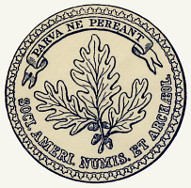 American Numismatic Society today unveiled the new interactive ANS archival search tool, ARCHER (numismatics.org/archives/). ARCHER (ARCHival Electronic Resource) provides access to the ANS' unrivalled collection of unique archival material, through a series of simple search screens.
American Numismatic Society today unveiled the new interactive ANS archival search tool, ARCHER (numismatics.org/archives/). ARCHER (ARCHival Electronic Resource) provides access to the ANS' unrivalled collection of unique archival material, through a series of simple search screens.
ARCHER is powered by EADitor, open source software developed by the ANS for creating, managing, and publishing collections of archival finding aids described in Encoded Archival Description (EAD) XML. Like the society's Collection database, MANTIS, ARCHER's public interface includes faceted searching and mapping of the collection. The administrative interface takes advantage of XForms, next-generation web forms, which enables the Society's archivist, David Hill, to create the finding aids with an intuitive user interface that requires no technical knowledge of XML, a major advancement over many institutions' current workflows.
"The Society's archives contains a rich diversity of material", notes Deputy Director Andrew Meadows. "On the one hand there are the Society's own archival records, spanning more than 150 years of our activity since 1858. As such, the archive is one of the oldest held by any learned society in the country. But in addition to that, the ANS also holds a remarkable archive of international significance, consisting of the papers of famous scholars, collectors and dealers in the field of numismatics. Documents, letters, notebooks and photographs relating to many famous individuals from within the numismatic community and beyond are held at the ANS. ARCHER provides a remarkably straightforward tool both for their cataloging, and for their search by the general public."
The search interface is built on similar technology to the Society's MANTIS database. Simple faceted searching based on personal names, places, dates, genre and Library of Congress subject headings are all provided. ARCHER also provides a map interface, which will allow users to visualize the places on the globe with relevant ANS archival material.
ANS Archivist David Hill explains, "What really sets ARCHER apart from other archives management systems is that it combines a simple method for the creation of full EAD with a powerful, built-in publishing feature that produces remarkably sophisticated finding aids. The faceted search capabilities give us an enhanced level of control over our archival holdings, ensuring that ANS staff and researchers can always find relevant materials from across our various collections."
The design of ARCHER is the work of ANS Web Developer Ethan Gruber, working in close collaboration with David Hill. The database supports a variety of export formats that will encourage exploration of the links between numismatics and other disciplines. As with MANTIS, underlying this work is a technical approach called 'Linked Open Data'. For the future this will mean increased opportunities both for the ANS to integrate searches across the whole range of its collections, such as books, coins, archives, and also for the rest of the world wide web to discover and link to our material. As Meadows notes, "The new suite of ANS search tools, comprising DONUM (the library catalog), MANTIS and ARCHER, will bring numismatic material to whole new audiences. In this the ANS is leading the world."
For more information, contact ANS Deputy Director Andrew Meadows (212) 571-4470 ext. 111, meadows@numismatics.org.
To access ARCHER, see: numismatics.org/archives/
For a sample archive entry, see: Henry Russell Drowne papers, 1884-1927 (numismatics.org/archives/show/nnan0045)
To read the complete press release, see: AMERICAN NUMISMATIC SOCIETY UNVEILS ARCHER: A BREAKTHROUGH IN ARCHIVAL CATALOGING (numismatics.org/wikiuploads/NewsEvents/11.3.11ArcherPR.pdf)
ANS MEDAL HONORING ERIC P. NEWMAN

The American Numismatic Society is pleased to announce the limited edition medal honoring ANS Trustee Emeritus, Eric P. Newman. The medal will be minted in both bronze and silver and will be available by subscription only until January 13, 2012.
About the Medal
Eric P. Newman, America's foremost numismatist, collector, and scholar celebrated his 100th birthday on May 25, 2011. In his honor and in recognition of his numerous achievements, the American Numismatic Society commissioned Philadelphia artist Amy Kann to create a bas relief portrait of Mr. Newman.
At his birthday celebration held in NYC, ANS Chairman of the Board, Kenneth L. Edlow, presented Mr. Newman with the framed relief portrait. The two-sided limited edition medal will utilize the design of the original 7.75 x 9.875 inch bas relief portrait of Mr. Newman on the obverse. The reverse depicts Mr. Newman seated and reading at a desk. The Newman medal will be struck in both bronze and silver after the subscription period on January 13, 2012.
About the Honoree
A beloved American numismatist, scholar, collector and philanthropist, Mr. Newman served on the ANS Council (Board of Trustees) from 1966 to
2003 when he was named Honorary Trustee. The Society presented its highest honor to Mr. Newman in 1978, with the Archer M. Huntington Medal in recognition of outstanding numismatic scholarship.
Mr. Newman has served the community and the ANS in many ways. In 1981 he fully endowed the ANS' celebrated Graduate Summer Seminar, which is now named in his honor. An article and complete bibliography of Eric P. Newman's published works were featured in the 2011 no. 2 issue of the ANS Magazine.
About the Artist
Amy Kann's sculpture is represented in the permanent collections of the Smithsonian Museum, the British Museum, the Brookgreen Gardens Museum and the National Sculpture Society. She was commissioned by the Brookgreen Gardens Museum to design and sculpt their 2010 bas relief medal. In 2010 Ms. Kann was nominated for the Anonymous Was a Woman Grant.
In 2006, she received the National Sculpture Society's Alex J. Ettl Grant for Sculpture, given to recognize a lifetime distinguished body of work by a non-member and, later in that year, she was elected into the society's membership. In 1988 she won First Prize, the Portrait Award from the National Sculpture Society.
Since then she has earned numerous awards such as Best in Show Awards from the Portrait Society of America Competitions, the Bronze Medal from National Sculpture Society, the First Place Award for Sculpture from the Salmagundi Club, along with many other awards from both the National Sculpture Society, the Audubon Society, the Allied Artists of America and the Catherine Lorillard Wolfe Society. She is represented by the James Graham and Son's Gallery of New York City, the Morris Whiteside Gallery of Hilton Head, SC and the Wendt Gallery of Laguna Beach, CA.
Medal Sponsors
The Eric P. Newman 100th Birthday bas relief's design and fabrication were generously sponsored by ANS Fellows Jonathan H. Kagan, Donald Scarinci, Lawrence R. Stack, and Anthony J. Terranova.
Medal Description
Size: 2.40 x 3.44 in. (60.7 x 87.3 mm)
Weight: Bronze: 198.2 g
Silver (.999 FS): 226.3 g
The Medalcraft Mint Inc., Green Bay WI, has been selected to die-strike the collection. Subscription information and Pricing
All orders for the medal must be received by January 13, 2012.
Bronze:
Regular Price: $58 ANS Member Price: $45
Silver
Regular Price: $498 ANS Member Price: $395 New York State Residents add 8.875% tax.
Shipping & handling costs: Domestic $10 + $7 each additional medal / International $15 + $10 each additional medal
If ordering quantity please contact the ANS at 212-571-4470 ext. 117 or orders@numismatics.org
To order on line or to download a subscription form, visit the ANS Store: http://www.numismatics.org/Store/NewmanMedal
For more information on this limited edition medal please contact 212-571-4470 ext. 117 or send an email to orders@numismatics.org
GRAB A BUSHEL BASKET:
IT'S THE NEW CHERRYPICKERS' GUIDE!
THE NUMISMATIST ONLINE PRESENT AND PAST
You asked if the online archives of The Numismatist go back to 1888. Of course not! They extend only to January 2009. The question came up because the ANA now makes the magazine available (not actually readable) on Android phones. Yes, Kindle and iPad are powerful and popular. I am sure that many people are happy reading The Numismatist while driving.
Earlier this year Whitman's Dennis Tucker quoted me in print on my not reading the magazine at all this year. Work was hard to find in southeast Michigan, so I saved a few dollars on my ANA membership by foregoing the print edition of the magazine. Although I wrote the "Internet Connections" column from 2005-2010, the truth is that I found the presentation difficult at best on either my PC or my Mac, and I just stopped trying. Pages are slow to load and difficult to view. Browsing is painful. Searches just grind and grind. Again, this clearly works for some people, but the print edition serves everyone.
I appreciate the power in text online. As an academic researcher, I swear before Thoth, Mercury, and the Muses that JSTOR and Gale Cengage are blessings from on high. But they are fast, slick, effective, powerful, and complete.
I challenge anyone reading The E-Sylum to goto the ANA website, enter "bowers" in the Search box and get a response. Try "dollar." Earlier this year, I wrote to the Executive Director, pointing out the problem. I got no reply. Of course, as it turned out, he was busy with other matters.
That was not my first attempt. While I confess to being something of a cyberphobe, I maintain that it is in the best tradition of computer hacking. I want things to work well for everyone. I have worked as a technical writer for information systems for financial and manufacturing applications. I served as the webmaster of the Michigan State Numismatic Society. Like Tron, I fight for the users. ANA members and the general numismatic public need someone who can beat the Master Control Program and release the data. But the ANA Board and management does not even perceive the problem.
To read the complete article, see: THE NUMISMATIST NOW AVAILABLE FOR ANDROID PHONES (www.coinbooks.org/esylum_v14n45a12.html)
IS COIN SEARCHING A WORLDWIDE ACTIVITY?
How many years has it been since you searched rolls of coins you got from the bank or some other source?
As a high school junior in 1946 I remember taking my pay envelope from the local A&P where I stocked shelves to the bank and bought as many nickel rolls as I could. In those days half the rolls were Buffalo nickels, with an occasional Liberty Head. That was F - U - N !
I have read recent articles of people searching coin rolls for scarce or unusual coins. This in English speaking countries, Australia, India and England.
This week I read an article of a Canadian with a new twist. He wanted to search a million cents. He had only $5,000 so he settled for half a million. He obtained 10,000 rolls from "a local coin processor" and began going through them manually one roll at a time.
Some looked on him as weird, others called him "Crazy Penny Sorter." He knew of a machine -- a Ryedale -- to aid in sorting old pennies from new. This machine was invented by Michigan collector Andrew Redlon (reported here in E-Sylum, Vol 11, No 15, Article 17, April 13, 2008). This machine will separate out both Canadian and American copper cents from more recently issued zinc variety.
But Crazy Penny Guy -- whose name was not released -- won't use the machine. He does it all manually. What's different he has found a sponsor, and has established his own blog to report on what he finds. Most impressive to date? A 1955 double die cent! Now who's crazy?
He's not forming a collection. He's selling off interesting specimens he finds.
Read the article, but also click on his blog at the end:
"Crazy" Penny Sorter Pledges To Hand-Sort 10,000 Rolls
(empowerednews.net/%E2%80%9Ccrazy%E2%80%9D
-penny-sorter-pledges-to-hand-sort-10000-rolls/1816657/)
QUERY: THOMAS ELDER PERIODICALS INFORMATION SOUGHT
Dave Hirt writes:
I have been looking at my Tom Elder periodicals of the period 1909-1911 and am a bit confused. Perhaps some of the readers can help. I have two issues of the Numismatic Philistine Oct & Nov 1909. Is there also a December issue?
Then in Jan 1910 started Vol I of The Elder Magazine which I believe was issued in 12 issues, although I am missing a couple. Next I have a Vol II #1 of The Elder Magazine ,Jan 1911. Were there more issues of Vol II issued?
QUERY: 1856 FLYING EAGLE PATTERN INFORMATION SOUGHT
Bruce writes:
I just got in a trade, an 1856 Flying Eagle One Cent piece. It's in at least MS63 (in my opinion) in a round plastic holder. The unusual thing about it is that it is in Brass and not the Cupro-Nickel of the normal coins. I'm having trouble deciding if it could be a pattern coin, but usually the pattern has a obverse or reverse design not used in the regular issues struck. I'm wondering if anyone knows if this could be a "trial strike" to see what metal combinations worked well with the trial dies. Anyone have any ideas?
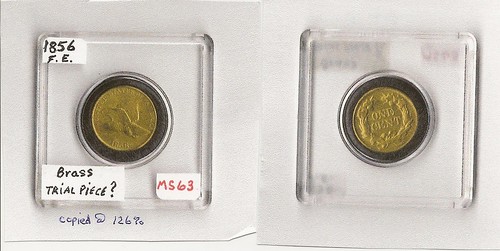
I didn't find an entry there for a brass/bronze/copper piece, but I pulled off the shelf my copy of the United States Pattern Coins book by Judd. I have the 10th edition, published by Whitman and edited by Dave Bowers with Saul Teichman's research assistance (Saul updates uspatterns.com).
The book has an entry for J-182 which is an 1856 Flying Eagle cent pattern in Bronze. An example was sold by Heritage in 2008. -Editor
MORE ON LIBYA'S STOLEN TREASURE OF BENGHAZI COIN COLLECTION
"Responsibility means the possibility of giving account for consequences, which are caused by oneself or other influences. ... Responsibility means the obligation to ensure that the development within one's own sphere of responsibility runs in accordance to the desired way", thus far a rough translation of the German Wikipedia article "responsibility".
Well, when we think of this definition, we have to declare that the Libyan government was acting in an extremely irresponsible way by hiding a treasure from the public without cataloguing it completely. This thoughtlessness renders it impossible to restore the stolen objects of the Benghazi treasure. I am sure, some archaeological hardliners will proclaim that it's only the greed of collectors and dealers, which seduced the poor Libyans to loot the bank of Benghazi and that we have to stop collecting at all in order to prevent looting.
But let's turn the tables: The American Institute of Archaeology has been excavating in Libya in cooperation with universities from North America and Europe since 2004. They have researched some sites in the Cyrenaica. That's nice, but wouldn't it have been more useful to catalogue and analyze the old material from excavations that never have been published?
I know this is just work and by far not as glorious and sensational as excavating. Nevertheless here is my demand on all archaeologists of the world: Stop excavating until you have published the old material that never has been edited on a scholarly basis! If you don't do so, it will be your fault that cultural property can't be found again on the market!
Interpol was alerted about the theft only in July. Information is ambiguous whether the accident occurred in May or in March. The robbers drilled through a concrete ceiling in the National Commercial Bank of Benghazi. In the vault they smashed metal storage cupboards and opened the sealed trunks that contained the "Treasure of Benghazi".
This treasure was composed of ca 7,700 coins, and of juwels and medallions, bracelets and necklaces, earrings and rings. Around 50 smaller objects among which statuettes, are to be added, some of bronze, others of glass or ivory and a small number of precious stones. The better part of these objects is said to date from Alexander the Great's epoch. Thus the first articles reported.
But now we hear that the treasure â€" kept in safe custody in two wooden military chests from the Second World War â€" was transferred from the bank to another bank building without authorisation. Only one of the two chests arrived, after the container in which they were transported, had been forced open.
Apparently the robbers proceeded very systematically. Hafed Walada, a Libyan archaeologist teaching at King's College, London, stated: "I have the feeling this must have been an inside job. The treasure was there for many years, not many people knew about it."
During the Second World War these artefacts had been exposed in the Colonial Museum of the Ministry of Italian Africa in Rome. It was only in 1961 that eventually the objects returned to Libya, where they were locked in the bank.
Now Interpol and UNESCO are at pains to find the treasure of Benghazi. But valuable time has been lost. There are rumors that the Transitional Council kept quiet about the event trying to avoid negative headlines. There is no hot lead, and archaeologists believe it improbable to find the objects once they have been brought out of the country.
Although the coins never have been photographed, bronze coins at the Libyan black market arose suspect of originating from the treasure. When the police detected a peasant in Egypt smuggling over 500 gold coins and a gold statuette, everyone hoped to have regained part of the treasure. Libyans who live in Egypt immediately collected money to buy the statuette back for their home country. But all these attributions are highly speculative. And after fifty years in the strongbox and as far as it appears without any decent publication, it seems quite difficult to identify which coins were part of this mysterious treasure and which not.
To read the complete article, see: Treasure Stolen in Benghazi or Hollywood the Libyan Way? (www.coinsweekly.com/en/News/4?&id=856)
To read the earlier E-Sylum article, see: LIBYA'S TREASURE OF BENGHAZI COIN COLLECTION STOLEN (www.coinbooks.org/esylum_v14n45a21.html)
THE BOOK BAZARRE
STILL MORE ON AMERICAN FAROUK AUCTION ATTENDEES
Gaston Di Bello
Harvey G. Stack writes:
One name of an important collector seems to be missing from the various lists of those who attend the Farouk Sale in Cairo.
A prominent collector, a close friend of John J. Pittman, as well as a good client of Stack's , Gaston Di Bello of Buffalo, attended the Farouk Sale as a collector and someone who helped some of those who bought at the sale with financial assistance. He was active in the Buffalo coin club and the Rochester Numismatic Society.
Before and after the Farouk sale, Gaston was generally at numismatic shows in New York City, New England Numismatic Conventions and loved to display some of his great rarities at the clubs as well as the conventions.
Gaston was not a boastful collector, but a great one. He knew that some of the coins in the Farouk Collection would be offered to him after the sale, so he went to see what he could get and at the same time save a commission to the dealer who might have represented him.
After he died, Stack's was invited to Buffalo by the trustees of his Estate, appraised the collection and sold it at Public Auction. It was noted for its high quality gold coins from the United States as well as a number of important foreign and ancient coins.
James Randall
Regarding the dispute between James Randall and the Miami Coin Club, David Ganz looked up the case records and sent me a copy. It's too long to reprint here, but the gist of the case was that Randall contended that he was expelled from the club without due process - that the club's bylaws had not been followed. This case is all about a technicality and says nothing about what the expulsion was actually about.
The record is dated June 13, 1956. It states that
On June 25, 1954, appellant was expelled from the group by majority vote of the executive committee, in accordance with the by-laws of the club. He was given no opportunity to be heard. At the time of his expulsion, he was not in Dade County but was in Broward County, where he resides.
The first judge in the case ruled in favor of the club, but Randall appealed. The section of the law regarding social clubs incorporated in Florida that was cited in the appeal states that
... provided, that before his membership shall cease against his consent he shall be given an opportunity to be heard, unless he is absent from the county where the corporation is located
So that's how Randall won his case
To read the earlier E-Sylum article, see: MORE ON AMERICAN FAROUK AUCTION ATTENDEES (www.coinbooks.org/esylum_v14n45a09.html)
STILL MORE ON COINS AND MEDALS AND METEORITES
Regarding the brief note on Halley's Comet, Leon Saryan writes:
There is a speculation that a certain series of ancient Armenian coins of Tigranes depicting a comet are intended to represent Halley's Comet which passed over the area ca. 87 B.C. A publication on this topic appeared in an astronomy journal. Here is a citation:
V. G. Gurzadyan and R. Vardanyan (4 August 2004). "Halley's Comet of 87 BCE on the coins of Armenian king Tigranes?". Astronomy & Geophysics 45 (4): 4.06. arXiv:physics/0405073. Bibcode 2004A&G....45d...6G. doi:10.1046/j.1468-4004.2003.45406.x.
Here's a link to one of the citations Leon listed: arxiv.org/abs/physics/0405073
George Cuhaj submitted this web site link: www.spacecollection.info/meteorite_coins/meteorite_coins.html
George adds:
Cook Islands in 2009 commemorated the 40th Anniversary of Moon exploration with a coin and a rock fragment, and a 400th anniversary of Mars Observations with a Mars fragment (Cook Islands 680 and 681 on Numismaster.com). Another Moon Landing with fragment coin from 2008 at 766.
Cook islands also did a Pultusk Meteorite coin in 2008, with a fragment. Cook Islands 618. And Brenham Meteor in 2007, KM 763.
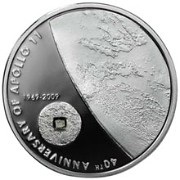
40th Anniversary of Moon exploration
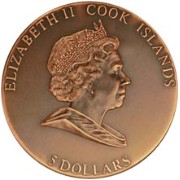
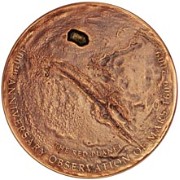
400th anniversary of Mars Observations

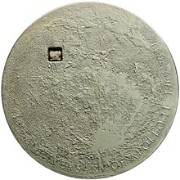
Moon Landing with fragment
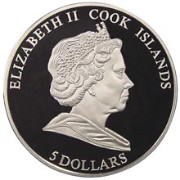
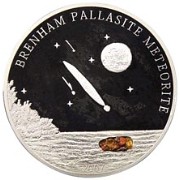
Brenham Meteor
To read the earlier E-Sylum article, see: MORE ON COINS AND MEDALS AND METEORITES (www.coinbooks.org/esylum_v14n45a20.html)
NOTES FROM E-SYLUM READERS: NOVEMBER 6, 2011
The Rush to Review the Cherrypickers' Guide
Regarding his recent request for people to write a review of the new Cherrypickers' Guide, Fifth Edition, Volume II, Dennis Tucker writes:
The response to that article in The E-Sylum was, I think, a good indication of the strength of the hobby community's interest in cherrypicking --- by Monday morning, I already had seven potential book reviewers lined up!
In addition to the review copy I offered in The E-Sylum, I decided to throw my own "publisher's copy" into the mix, since so many readers were interested in the book.
I drew two names at random, and will be sending review copies to Michael Luck and Tony Hine. To everyone else: I look forward to hearing your thoughts after the new Cherrypickers' Guide debuts later this month.
Thank you to all who volunteered to review this latest volume.
To read the earlier E-Sylum article, see: REVIEWER SOUGHT FOR CHERRYPICKERS' GUIDE, FIFTH EDITION, VOLUME II (www.coinbooks.org/esylum_v14n44a05.html)
Moneymakers Reviewed
Regarding Moneymakers by Ben Tarnoff, Ute Wartenberg Kagin of the American Numismatic Society writes:
You'll find a very good review of this book on www.nybooks.com/issues/2011/nov/10/ . It is fascinating how this topic has suddenly caught the attention of the general public.
The review is by Gordon S. Wood, titled "American Dream Money" ins the New York Review of books.
Howard Daniel in Singapore
Howard Daniel is traveling and Friday he published a report in the MPC Gram about Chinese Gold Unit Notes. In his preface to his story he told of his recent visit to see numismatic friends in Singapore.
I departed the USA on Oct 5 and arrived here in my townhouse in Ho Chi Minh (Saigon) on Oct 6. Three days later, I was in Singapore with one of my nieces. We attended a Chinese Wedding Dinner that evening for a lady cash-style coin collector friend. She sat us at a table with four Chinese coin dealers. They were speaking only in Chinese and my niece and I were speaking only in English. We stared at them and they stared at us.
So in my shy manner, I stood up and introduced myself. The men immediately recognized my name from the local numismatic society membership roster (I am a life member) and one said he remembered I spoke at a meeting many years ago. The one man who could speak English moved next to me and translated for me to the dealers and for my niece to the wives. It was a great time!
We came back to Viet Nam on Oct 11. I am now preparing for trips to Bangkok, Phnom Penh, Vientiane and Hanoi. I also am trying to obtain an appointment in the new Ho Chi Minh Trail Museum in Buon Me Thuot in the Central Highlands.
The MPC gram is an electronic publication for collectors of Military payment Certificates and other forms of Military money. It is published by Fred Schwan (fredschwan@yahoo.com). -Editor
Superman #1 For Sale
Tom Fort writes:
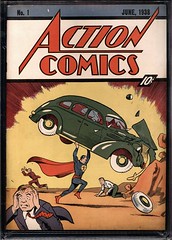 Last week I sent you the note about the cheque from DC comics for the rights to Superman. Now the highest graded surviving copy of that famous issue is going up for auction as well. A somewhat lesser copy sold for 1.5 million a couple of years ago. The book and information about it can be found here:
www.metropoliscomics.com
You will have to scroll down a bit.
Last week I sent you the note about the cheque from DC comics for the rights to Superman. Now the highest graded surviving copy of that famous issue is going up for auction as well. A somewhat lesser copy sold for 1.5 million a couple of years ago. The book and information about it can be found here:
www.metropoliscomics.com
You will have to scroll down a bit.
Joe Schuster's original cover still exerts a lot of influence today. It was used for a scene in the film Superman Returns and comic artist Alex Ross did his own take on the image for Action Comic's 900th issue.
To read the earlier E-Sylum article, see: 1938 "SUPERMAN" CHECK OFFERED FOR SALE (www.coinbooks.org/esylum_v14n45a17.html)
PAN Banquet Honors Hobby Stalwarts
In response to my emailed question about the recent American Numismatic Association show in Pittsburgh, Rich Jewell writes:
The exhibits were first class. All six classes had a record three winners. Sam Deep ran away with the Best in Show and the People's Choice Awards, for his "Off the Beaten Numismatic Path" exhibit. Approximately eight PAN and WPNS members won exhibit ribbons and awards, Tom Uram, yours truly, Rich Crosby, Paul Schultz, Tom Corey, John Eshbach, Josh Wadsworth and Sam Deep. This must be a record of some sort!
The PAN Banquet at the Lemont was outstanding. Over a hundred people came out to honor PAN's three Lifetime Achievement awardees, John Eshbach, Gerry Kochel and Dick Duncan. The food was great, the scenery from Mount Washington was spectacular, we had rainbows and fireworks, too! What a gala evening!!!
I think the LeMont venue was a great choice. Perched atop a hill directly across from downtown Pittsburgh, the views are spectacular. Beats a windowless hotel banquet room by a zillion miles.
I've been away from Pittsburgh for about five years now, but it's my numismatic heartland. The Western Pennsylvania Numismatic Society (WPNS) and Pennsylvania Association of Numismatists (PAN) are among the best local and state organizations in the country.
Escbach, Kochel and Duncan are stalwarts of PAN as well as the American Numismatic Association. They are grassroots giants in the hobby. I'm sorry I couldn't be there, but I'm glad to hear there was such a great turnout for the event. Congratulations!
The Armand Champa Refrigerator Magnet
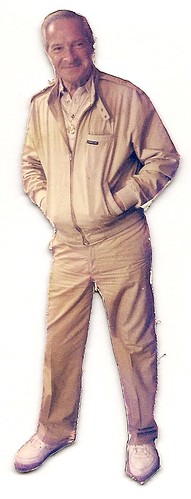 Web site visitor Amanda Champa writes:
Web site visitor Amanda Champa writes:
I read an article about the Armand Champa magnets and found it so interesting. Could you tell me who wrote it? Armand Champa is my grandfather.
Here's an excerpt from that article:
Having visited famed numismatic bibliophile Armand Champa at his Louisville home, I had a photo of him I'd taken with my camera. On a whim, I took the picture to a photo shop and had it made into three refrigerator magnets.
I replied:
I wrote that piece. I was among a group of collectors Armand invited to his home to view his library. I visited two or three times. I've always been grateful to him for the opportunity. I was young and just beginning my own library, and learned a great deal from my visit and made several lifelong friends from the first event. I probably wouldn't be editing this newsletter if it weren't for him.
He was a very gracious and generous host. I always looked forward to seeing him at our conventions. I bought a few books from his library when it was auctioned.
To read the earlier E-Sylum article, see: THE MAGNETIC PERSONALITY OF BIBLIOPHILE ARMAND CHAMPA (www.coinbooks.org/esylum_v12n49a17.html)
Crowdsourcing the Skewing Technique
John MacVean writes:
When I originally figured out the signature on the note it was a group effort. I posted the information on the US Coin Collecting website along with the picture of the note from this newsletter and a blowup of the signature that I had skewed. Here is that post:
Can you figure out the name on this North Carolina 10 cent note.
Posted by Caveman144 on October 3, 2011 at 3:15pm in U.S. Coin Collecting View Discussions
A collector from E-sylum is trying to figure out the signature on a 10 cent note from North Carolina. He has looked up records of those authorized to sign and can't match the name on the note to the authorized list.
Here are pictures of the note, the signature as it appears on the note and the signature after I got done playing with it in Paint Shop Pro X2. (see attached)
Here is the link to my original post:
uscoin.ning.com/forum/topics/can-you-figure-out
-the-name-on-this-north-carolina-10-cent-note

To read the earlier E-Sylum article, see: SKEWING - A TECHNIQUE FOR SIGNATURE IDENTIFICATION (www.coinbooks.org/esylum_v14n43a06.html)
REPORT ON THE 2011 MEDALLIC SCULPTURE SYMPOSIUM
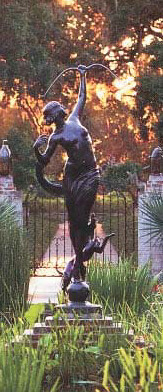 Last July, the American Medallic Sculpture Association and the National Sculpture Society co-sponsored a two-day long symposium on medals at the Brookgreen Sculpture Gardens, just south of Myrtle Beach, S.C. There they gathered a group of established artists, as well as authors and the Brookgreen curators, to spread the word and the techniques of how art medals are produced.
Last July, the American Medallic Sculpture Association and the National Sculpture Society co-sponsored a two-day long symposium on medals at the Brookgreen Sculpture Gardens, just south of Myrtle Beach, S.C. There they gathered a group of established artists, as well as authors and the Brookgreen curators, to spread the word and the techniques of how art medals are produced.
The art medal is created simply because it is a work of art and is beautiful. The theme or themes are as varied as the artist wishes them to be. Certainly, the artist can also be a person who is commissioned to create medals for organizations, even governments, to honor a specific individual or an achievement. But the same artist can create medals simply for their form and beauty.
In the case of the summer symposium, it was accomplished sculptor and medalist Eugene Daub who gave one of the opening welcomes at Brookgreen, thanking everyone for attending. As well, Brookgreen Sculpture Garden curator Robin Salmon welcomed participants to the event, and discussed the relationship between medallic art and sculpture as a broader art form. Her history of Brookgreen Gardens was fascinating.
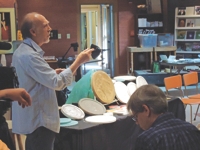 Noted sculptor Jim Licaretz fascinated those in attendance by demonstrating 3-D modeling for medals using a computer, showing how the computer can be used to create the full design. Licaretz noted that the U.S. Mint currently uses such software when the call comes from Congress for certain medal designs.
Noted sculptor Jim Licaretz fascinated those in attendance by demonstrating 3-D modeling for medals using a computer, showing how the computer can be used to create the full design. Licaretz noted that the U.S. Mint currently uses such software when the call comes from Congress for certain medal designs.
Equally as interesting, he noted that this particular software was used by surgeons, and gave an example of how a portion of a patient's skull had been modeled, after an accidental head injury, to create a reproduction for replacement of the damaged portion. Many avid collectors have noted connections between coin collecting and a host of other arts and sciences, but reconstructive surgery? It's amazing to see a link like this.
A real learning experience for those who attended the Brookgreen symposium was Daub sharing his knowledge of carving in plaster. To watch Daub work in the medium, to see the first step in getting to a finished medal, was truly amazing. In addition, Daub had brought several examples of plasters and other designs he had created, all of which had eventually been produced as medals for one client organization or another.
Now, the surface of a coin is tremendously important to most collectors and, indeed, such eye appeal oftentimes determines the value of the piece. But those of us who are strict coin collectors tend to want clean surfaces only, with the possible exception of those who look for toned coins with pleasing looks.
At the Brookgreen symposium, accomplished artist Heidi Wastweet gave an eye-opening demonstration of how various patinas are applied to a surface, since not all art medals are designed to have to have a raw metal surface and look. It was very interesting to see what starts out as art turn into some serious science, as the various chemical processes that patinate a medal are applied to the surface.
To read the complete article, see: The Art of Medal Making (www.numismaster.com/ta/numis/Article.jsp?ad=article&ArticleId=24312)
To read the earlier E-Sylum article, see: 2011 MEDALLIC SCULPTURE SYMPOSIUM AT BROOKGREEN SCULPTURE GARDENS (www.coinbooks.org/esylum_v14n26a13.html)
THE BOOK BAZARRE
COINS 'N' THINGS' $6.5 BILLION BUSINESS
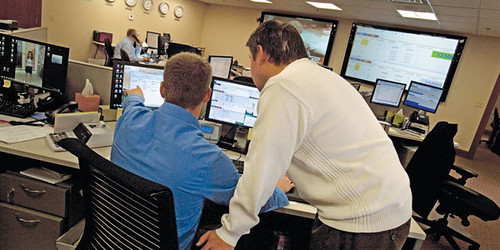
In 1973, Louis Oliari opened Coins 'N Things, a small storefront between a Dairy Queen and a hair salon in Brockton, Mass. His teenage son Mark had become obsessed with coin trading, and Louis, an engineer and a coin enthusiast himself, figured if he indulged the kid he'd eventually outgrow the hobby and go to college. "The whole idea was that I'd get bored and get this out of my system," Mark, now 54, remembers.
Today, Coins 'N Things is the largest seller of raw gold to the federal government. In the fiscal year that just ended, the U.S. Mint, which has bars made into coins for collectors and investors, bought $1.86 billion worth of the metal from the Bridgewater (Mass.) company. Not too shabby, considering that Coins 'N Things and the Mint struck their first deal less than two years ago.
The family's fondness for coins began when Louis Oliari was laid up with a knee injury and his wife gave him a book about coin collecting. Father and son began hoarding pennies from their local bank, assembling complete collections by decade. By age 13, Mark was attending trade shows. Then came the storefront. Business grew so quickly that after Mark finished high school, Louis let him trade coins full-time. It wasn't long before Louis left his job at Honeywell (HON) to join him.
Several years later, Coins 'N Things expanded into the wholesale metals market, acquiring clients such as hedge funds as well as jewelers and manufacturers that use raw gold. That was Mark's passion. His father preferred to help coin collectors and "had no conception of where this thing would go," says Mark. "He'd look in our section where I'm wheeling and dealing, making probably 400 phone calls. He'd say, 'Wow, you guys are probably doing three or four million dollars a year now.' I'd say, 'Dad, that is a good day.'"
Annual revenue is now about $6.5 billion, 65 percent of which comes from gold. Mark won't reveal profits but says the company pockets about a quarter of a percent of its precious metal sales-less for the gold it sells to the government. With 50 employees, including Mark's two daughters and a son, Coins 'N Things is still a family affair.
In September, gold hit a record $1,921.15 an ounce, a long way from the $103 it sold for in 1973 when the storefront opened. When Louis died in 2008, Mark finally closed the retail business that sold to collectors. "My father, God love him-he wanted to stay a little coin shop."
To read the complete article, see:
The Family That Sells Gold to the Government
(www.businessweek.com/magazine/the-family-
that-sells-gold-to-the-government-11032011.html)
17TH-CENTURY CHINESE COIN FOUND IN YUKON
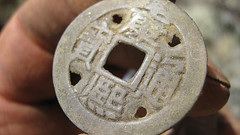 Archeologists have unearthed a coin more than 300 years old northwest of Carmacks, Yukon, which provides a link between 17th-century China, Russian traders and First Nations people.
Archeologists have unearthed a coin more than 300 years old northwest of Carmacks, Yukon, which provides a link between 17th-century China, Russian traders and First Nations people.
The find came in July as a team checked the route of a proposed mining road for the Western Copper and Gold Corporation's planned Casino gold mine.
The Chinese coin, which is round with a square hole in the centre, helps fill in the blanks on some pre-Gold Rush history.
James Mooney, from Ecofor Consulting Ltd., and his team were doing the heritage impact assessment for the proposed mining road.
"I was less than a metre from our archeologist Kirby Booker when she turned over the first shovel of topsoil and I caught sight of something dangling from the turf. It was the coin - the neatest discovery I've ever been part of," Mooney said.
Mooney believes there's a logical explanation for how the coin found its way deep into the Yukon interior hundreds of years ago.
"The first documented accounts of foreigners getting into Tlingit territory were in the mid-1700s. Russian traders [were] coming in and they were collecting sea otter pelts and some of the inland furs, and they would trade things like glass beads, silks and coins," he said.
Heritage Canada says the coin was minted between 1667 and 1671. It says the coin adds to the body of evidence that the Chinese market connected with Yukon First Nations through Russian and coastal Tlingit trade.
The coin is different from others of its type because it has four additional small holes above each corner of the central square.
"The extra holes could have been made in China. Coins were sometimes nailed to a gate, door or ridgepole for good luck. Alternatively, First Nations might have made the extra holes to attach them to clothing," said Mooney.
The coins could have been used as decoration or sewn in layers like roofing shingles onto hide shirts to protect warriors from arrows.
The coins are more common along the coast, but only three have been found in Yukon.
A matrix archeologist found another one in the Kwanlin Dun region this past summer. That was dated between 1724 and 1735. An even older coin was found in 1993 by Beaver Creek, which was dated between 1403 and 1424.
To read the complete article, see: 17th-century Chinese coin found in Yukon (www.cbc.ca/news/canada/north/story/2011/11/01/north-acient-coin-found.html)
MORE ON THE 1841 MAUNDY THREEPENCE
Jeffrey P. LaPlante writes:
I find it difficult to believe that the Thruppence referred to by Darrell Lewis could in fact be Maundy money, you see Maundy money is given by the Sovereign of England to poor folks as alms, it comes from the word mandatum and refers to Christ who said "If I then, your Lord and Master, have washed your feet, ye also ought to wash one another's feet. For I have given you an example, that ye should do as I have done unto you."
Mandatum is the derivation of the word "Maundy", and the Royal Maundy service evolved from Jesus' command to his disciples it was at first paid out in the form of food and clothing but the receivers of said generosity used to sell the food and clothing and so little bags of specially minted coins were given as alms to the selected poor folks.
In 1841 each recipient was given a set of four coins a One pence, Two Pence, Three Pence, and Four Pence silver coin. These coin sets had cases and usually were not meant to be spent, there is a great photo of the cases located here: www.maundymoney.info/92776.html
and more information than Darrell could ever want here: www.maundymoney.info/5103/index.html
As I said most of these coins were kept together as sets and the money was usually never spent and it is very rare.

Martin Purdy writes:
I'm intrigued by the "Maundy 3d" question, and still can't quite follow why identifying the coin as Maundy or not should have any bearing on the identification of the human remains as Leichhardt's. 1841 3ds were struck in quantity, are not scarce, and being intended for "Colonial use" would likely have been found in the Australian colonies seven years later anyway.
As far as I am aware there is nothing to distinguish the two types apart from the finish, which as your writer notes would be impossible to distinguish because of the amount of wear. Ordinary silver 3ds were commonly (and erroneously) nicknamed "Maundy 3ds", which might have led to the term being applied when the coin was first identified.
Surely if a bright, new Maundy 3d had come into Leichhardt's possession (how?) in England in 1841 and been retained as a keepsake, it would have been carefully wrapped or otherwise well looked after, and not suffered the sort of wear attributable to several years of heavy circulation.
For the record, one of my old COIN Year Books records 2574 Maundy sets being produced in 1841, with the mintage of the circulating version "unrecorded".
Just my 3d worth, anyway :-)
Philip Mernick writes:
There certainly would be no way of distinguishing a Maundy coin from a circulation issue after 100+ years of burial! If nobody comes up with the number issued for circulation I can ask the Royal Mint if they have it.
From Darrell Lewis' original query:
A book the dealer showed me (Coins of England & the United Kingdom - Spink, 2008) said that there were 'ordinary' threepences issued in 1841, 'for Colonial use only'. If all this is correct, then the threepence found at the 'skeleton' site, being quite worn, could not reliably be identified as a Maundy threepence and all the speculation about a possible connection with Leichhardt is completely misplaced.
I would like to find an expert who can tell me whether in 1841:
A) ordinary threepences definitely were produced?
Yes
B) If they were, was the design of the Maundy and the ordinary threepence identical?
Only the finish distinguishes the two types of pieces. The finish is lost from a heavily circulated piece, so in that case there is no way to tell.
C) How many 1841 Maundy threepences were struck?
They were struck in quantity, are not scarce, and being intended for "Colonial use" would likely have been found in the Australian colonies. The number struck was not recorded, but as noted the circulation pieces are not rare.
To read the earlier E-Sylum article, see: QUERY: THE 1841 MAUNDY THREEPENCE (www.coinbooks.org/esylum_v14n45a19.html)
CANADA'S NEW POLYMER BANKNOTES CAUSING MACHINE PROBLEMS
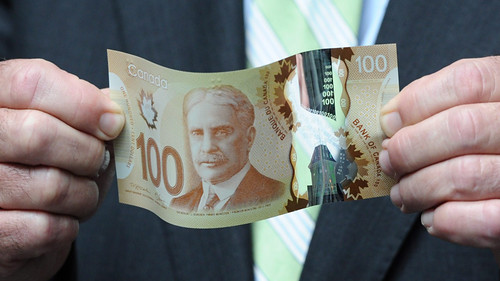
The new $100 polymer bills released this month are purported to be more durable and secure, but the plastic currency is already garnering criticism just weeks before circulation due to the cost they may cause small businesses.
The Bank of Canada announced new polymer bank notes in June 2011. The first bill, the $100 note, will be released Nov. 14.
The bills are being touted as a more convenient currency because the added security features makes it much more difficult to counterfeit.
However, Ted Brosnan, president of John Poulet Cheque Writer Service, said that the new bills will not initially make life any easier, especially for small businesses.
"It's because of the design of the bills," Brosnan, whose company sells currency counters, told CTV Toronto.
The new bills have a large transparent window that makes the currency undetectable in counters and even some ATMs, he said.
"Probably 99 per cent of the market uses money counters with optics," Brosnan explained, adding that the machines won't register a bill in the counter if the sensor doesn't pick it up.
"Because the one side is clear, the machine doesn't see anything and registers an error."
He said that this means almost every bill counter used by bank tellers and many businesses will need to be replaced.
"Some smaller financial institutions are in the position where they have to replace their ATMs as well as their money counting machines, in that case it can be a large expense that they haven't counted on," he said.
To read the complete article, see:
Polymer bills could cause businesses headaches
(www.ctv.ca/CTVNews/SciTech/20111106/
new-polymer-bills-transition-111106/)
CASH MACHINE DISPENSES COCKNEY RHYMING SLANG
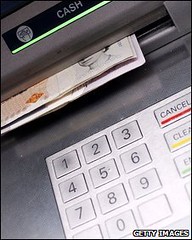 A cash machine operator has introduced Cockney rhyming slang to a number of its ATMs in east London.
A cash machine operator has introduced Cockney rhyming slang to a number of its ATMs in east London.
People using Bank Machine's ATMs can opt to have their prompts and options given to them in rhyming slang.
As a result they will be asked to enter their Huckleberry Finn, rather than their Pin, and will have to select how much sausage and mash (cash) they want.
The rhyming slang prompts will be available from five cash machines in east London for three months.
Other rhyming slang prompts people can expect include a speckled hen (£10), while the machine may inform users that it is contacting their rattle and tank, rather than bank. Ron Delnevo, managing director of Bank Machine, said: "We wanted to introduce something fun and of local interest to our London machines.
"Whilst we expect some residents will visit the machine to just have a butcher's (look), most will be genuinely pleased as this is the first time a financial services provider will have recognised the Cockney language in such a manner."
To read the complete article, see: Cockney rhyming at cash machines (news.bbc.co.uk/2/hi/uk_news/england/london/8217499.stm)
FEATURED WEB SITE: THE JOHN REICH COLLECTORS SOCIETY
This week's Featured Web Site is the John Reich Collectors Society (JRCS).The purpose of the John Reich Collectors Society (JRCS) is to encourage the study of numismatics, particularly United States gold and silver coins minted before the introduction of the Seated Liberty design, and to provide technical and educational information concerning such coins.
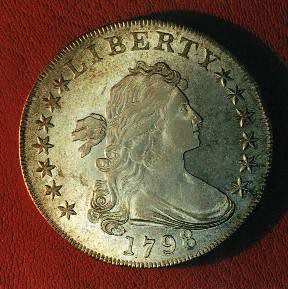
http://jrcs.org/
